Written by The Good Earth School Teacher Rivi Dollinger
It’s a bright and sunny day as the Oaks students play in the meadow. Some of the toddlers climb up and down the hilly incline, where I seat myself at the top to monitor the area. Two of the oaks sit next to me, sorting sticks and leaves into piles at my feet. “Where’s the toy?” I hear one of them ask the other. They are not referring to a commercial toy, but rather a small rock they found that had been designated to be the baby toy. The baby was a pinecone, and the mama was a large stick. They are creating worlds inside their small nature nest, exploring the world around them and their imagination.
It’s a foggy morning as I set up the loose parts table in the redwood classroom. I set out a couple of bowls and a tray, sliding my fingers along the windowsill where glass jars reside. Each jar is filled with various loose materials: string rolled up and tied into bows, small clear pebbles, corks, beads, shells, and more. I grab a handful of cinnamon sticks, which offer the benefit of scented exploration, and pour half a bowl of glass pebbles. I smile as I hear the gentle clink of the rattling stones. I lift a cinnamon stick to my face and breathe in the earthy scent. Finally, I plant a single stick into the middle of the bowl, a focal point for my own creative vision.
Loose Parts are an integral part of The Good Earth School philosophy and vision. In addition to its environmental and sustainability benefits, psychologists are beginning to study the positive developmental impact of open-ended play with loose parts.
A few books have been written on this topic. The most noteworthy is “Loose Parts” by Lisa Daly and Miriam Beloglovsky, as well as two, follow-ups (Loose Parts 2 and Loose Parts 3). Finding the scientific basis behind why a box can be a child’s favorite play toy may open up new understandings in our culture and our society.
America, and western society as a whole, is incredibly consumerist. Unfortunately, this is taking a toll on the planet as well as on our mental health. Populations who own more tend to have lower happiness levels and lower quality of life. The growing popularity of Marie Alonso and practical minimalism offers insight into how clutter and single-use objects can infect our lives.
Our children don’t learn their best from strategically designed mass-produced toys with a single purpose and a tendency to break down or outgrow. This is not to suggest that commercial toys have no place in play; quite the opposite. It is by combining loose parts with beloved toys that our children will grow up into the humble, mindful, creative, and cooperative adults our society needs.
Loose parts work creativity, innovative thinking, motor skills, social-emotional concepts, cognitive learning, and more without costing a dime. Loose parts can work on flexible thinking and out of the box solutions. Loose parts show the endless possibilities of objects and of interactions. Loose parts demonstrate a connection to the world around us— not just in play, but in life.

